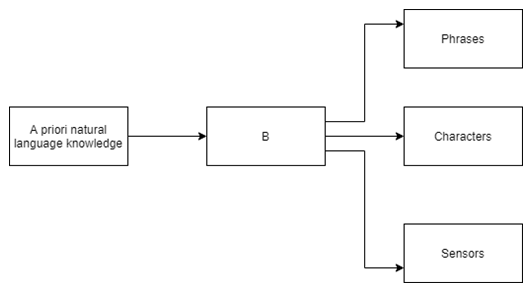This set of Cognitive Radio Multiple Choice Questions & Answers (MCQs) focuses on “Architecture – Inference Hierarchy – 1”.
1. Which among the following is an outcome of inference hierarchy?
a) Organisation of data structures
b) Control of internal flow of information
c) Control of external flow of information
d) Dissemination of knowledge
View Answer
Explanation: The inference hierarchy organises the information from observation to action phase in the corresponding data structures. It aids in including machine learning with real-time performance during the wake epoch.
2. Which among the following occupies the bottom most position in inference hierarchy?
a) Primitive stimuli
b) Atomic symbols
c) Primitive symbols
d) Atomic stimuli
View Answer
Explanation: Atomic stimuli refer to the external signals available from the outside world in unprocessed form. It includes the RF, image, location, and acoustic information that enter from the outside environment.
3. What is the atomic symbol equivalent of an image?
a) Small group of blocks
b) Small group of phoneme
c) Small group of pixels
d) Small group of points
View Answer
Explanation: Atomic symbols succeedatomic stimuli. It is the most fundamental symbolic units of a domain. Phonemes are considered as the most primitive form of speech. Pixels are considered most primitive form of an image.
4. Which among the following is obtained by collection of atomic symbols?
a) Aggregated sequence
b) Atomic sequence
c) Primitive sequence
d) Primary sequence
View Answer
Explanation: Primitive sequence is formed by assembling similar atomic symbols in a coherent manner. Primitive sequences generally have spatial or temporal likeliness which is visible and can be identified from a heap of information.
5. Which is the primitive sequence equivalent of text?
a) Sentence
b) Paragraph
c) Word
d) Character
View Answer
Explanation: Primitive sequence is formed by assembling similar atomic symbols in a coherent manner. Words that compose a text, tokens that form speech in a speech composer, and objects that form an image are examples of primitive sequence in their respective domains.
6. What is the capability of a basic sequence?
a) Communicate message with meaning
b) Construct a word
c) Identify useful information from data
d) Collect data
View Answer
Explanation: Basic sequence can deliver messages with meaning. These messages are defined using the ontology made available by primitive sequence. For example, a phrase (basic sequence) is constructed using words (primitive sequence).
7. What is the visual information equivalent of a basic sequence?
a) Blob
b) Object
c) Image
d) Video clip
View Answer
Explanation: Primitive sequence is succeeded by basic sequence. Context can be drawn from the information offered by a basic sequence. Phrases composed of words and video clip composed of images are examples of basic sequences.
8. Which among the following is concerned with syntax and semantics of information?
a) Sequence cluster
b) Basic sequence
c) Primitive sequence
d) Atomic symbols
View Answer
Explanation: Sequence clusters are developed on the basis of shared properties. Knowledge discovery and data mining (KDD) and the semantic web provide various means for defining or determining sequence clusters from basic and primitive sequence.
9. What is degree of association required for context cluster?
a) Space-Time association
b) Time-Frequency
c) Frequency-Time association
d) Space-Time-Frequency association
View Answer
Explanation: Context cluster is developed by space-time-frequency association on a multidimensional level. It is accomplished by using unsupervised machined learning using statistical or non-linear methods.
10. Which among the following is a non-linear machine learning techniques?
a) Linear regression
b) Logistic regression
c) Discriminant analysis
d) Support vector machines
View Answer
Explanation: Support vector machine is a supervised machine learning algorithm. It consists of learning algorithms that study data related to classification and regression analysis. It is typically used for creating context clusters in inference hierarchy.
11. The identification of “baseball” from words such as “hit”, “pitch”, and “run” is possible only by the functionality level of context cluster.
a) True
b) False
View Answer
Explanation: Sequence cluster is capable of determining themes from basic sequences that share similar characteristics. The capability of context cluster is to comprehend a discussion on baseball and draw conclusions based on the actions of the user.
12. What is the minimum requirement for taxonomy on radio knowledge?
a) Speed
b) Approximate models
c) Abstraction
d) Polymorphism
View Answer
Explanation: Abstraction includes the construction of formal and informal models of meta- knowledge ranging from concepts to structured mathematical models of space, time, and frequency. Taxonomy requires a hierarchical model capturing the physical world as well as the internal structure radio.
13. Which among the following may be used for processing speech channels?
a) Symbol processing
b) Natural Language processing
c) Speech synthesiser
d) Text synthesiser
View Answer
Explanation: Speech channels may be processed by using natural language processing facilities that have significant a priori models of language and discourse. Natural language processing is generally embedded in the inference hierarchy of cognitive radio.
14. XTAG caters to the requirement of cognitive radio.
a) True
b) False
View Answer
Explanation: Cognitive radio should initiate transmission when it receives a command “transmit” with an attached message. However XTAG abilities only allow differentiating a verb from a noun but it cannot comprehend the meaning of a command and initiate action.
15. Which among the following option should replace the block labelled “B”?

a) Observe phase
b) Natural language processing functions
c) Mappings
d) Orient phase
View Answer
Explanation: Sensory information, characters, words, and phrases are a part of the hierarchical structure of observe phase. They are mapped to the natural language processing function which uses information from a priori natural language knowledge. Natural language processing is required to integrate speech, and textual exchanges in cognitive radio.
Sanfoundry Global Education & Learning Series – Cognitive Radio.
To practice all areas of Cognitive Radio, here is complete set of 1000+ Multiple Choice Questions and Answers.
If you find a mistake in question / option / answer, kindly take a screenshot and email to [email protected]
